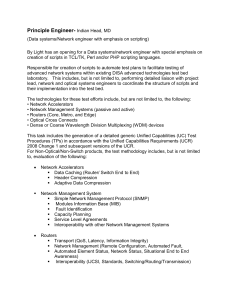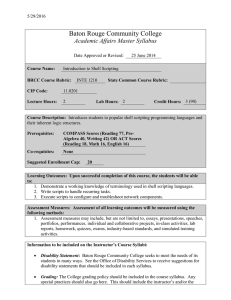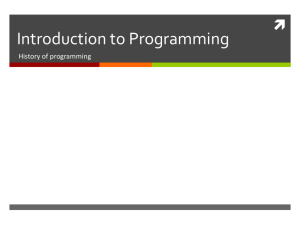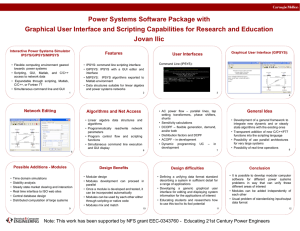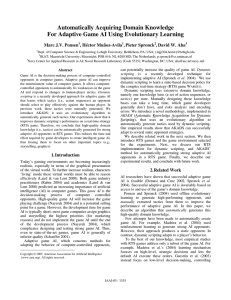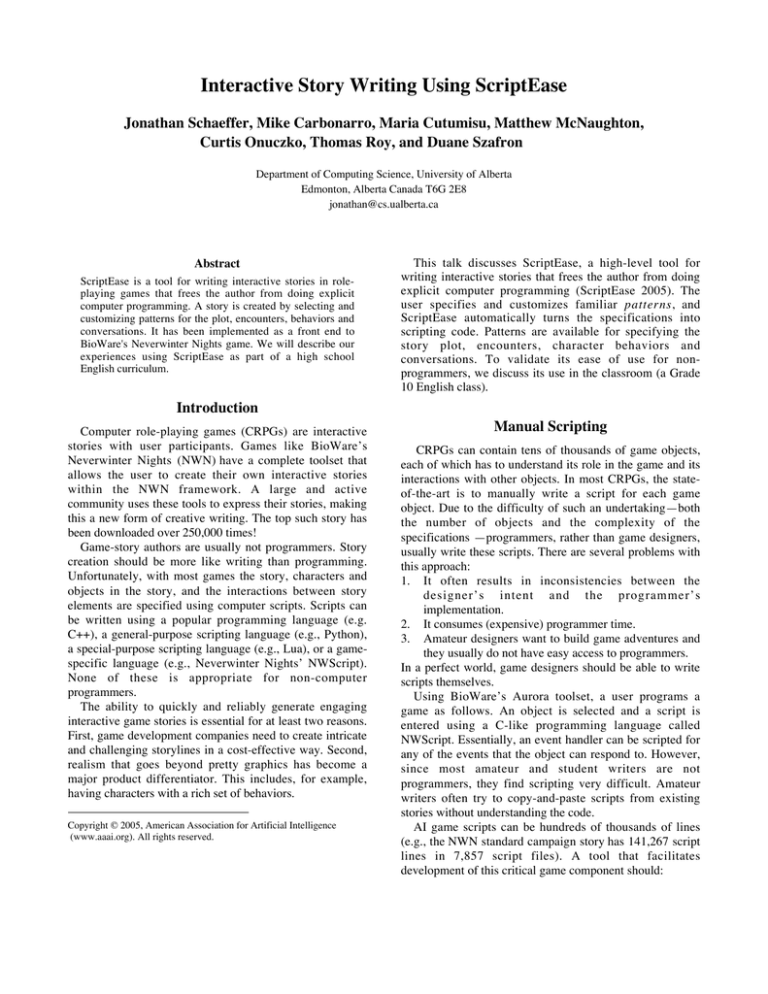
Interactive Story Writing Using ScriptEase
Jonathan Schaeffer, Mike Carbonarro, Maria Cutumisu, Matthew McNaughton,
Curtis Onuczko, Thomas Roy, and Duane Szafron
Department of Computing Science, University of Alberta
Edmonton, Alberta Canada T6G 2E8
jonathan@cs.ualberta.ca
Abstract
ScriptEase is a tool for writing interactive stories in roleplaying games that frees the author from doing explicit
computer programming. A story is created by selecting and
customizing patterns for the plot, encounters, behaviors and
conversations. It has been implemented as a front end to
BioWare's Neverwinter Nights game. We will describe our
experiences using ScriptEase as part of a high school
English curriculum.
This talk discusses ScriptEase, a high-level tool for
writing interactive stories that frees the author from doing
explicit computer programming (ScriptEase 2005). The
user specifies and customizes familiar patterns, and
ScriptEase automatically turns the specifications into
scripting code. Patterns are available for specifying the
story plot, encounters, character behaviors and
conversations. To validate its ease of use for nonprogrammers, we discuss its use in the classroom (a Grade
10 English class).
Introduction
Computer role-playing games (CRPGs) are interactive
stories with user participants. Games like BioWare’s
Neverwinter Nights (NWN) have a complete toolset that
allows the user to create their own interactive stories
within the NWN framework. A large and active
community uses these tools to express their stories, making
this a new form of creative writing. The top such story has
been downloaded over 250,000 times!
Game-story authors are usually not programmers. Story
creation should be more like writing than programming.
Unfortunately, with most games the story, characters and
objects in the story, and the interactions between story
elements are specified using computer scripts. Scripts can
be written using a popular programming language (e.g.
C++), a general-purpose scripting language (e.g., Python),
a special-purpose scripting language (e.g., Lua), or a gamespecific language (e.g., Neverwinter Nights’ NWScript).
None of these is appropriate for non-computer
programmers.
The ability to quickly and reliably generate engaging
interactive game stories is essential for at least two reasons.
First, game development companies need to create intricate
and challenging storylines in a cost-effective way. Second,
realism that goes beyond pretty graphics has become a
major product differentiator. This includes, for example,
having characters with a rich set of behaviors.
Copyright © 2005, American Association for Artificial Intelligence
(www.aaai.org). All rights reserved.
Manual Scripting
CRPGs can contain tens of thousands of game objects,
each of which has to understand its role in the game and its
interactions with other objects. In most CRPGs, the stateof-the-art is to manually write a script for each game
object. Due to the difficulty of such an undertaking—both
the number of objects and the complexity of the
specifications —programmers, rather than game designers,
usually write these scripts. There are several problems with
this approach:
1. It often results in inconsistencies between the
designer’s intent and the programmer’s
implementation.
2. It consumes (expensive) programmer time.
3. Amateur designers want to build game adventures and
they usually do not have easy access to programmers.
In a perfect world, game designers should be able to write
scripts themselves.
Using BioWare’s Aurora toolset, a user programs a
game as follows. An object is selected and a script is
entered using a C-like programming language called
NWScript. Essentially, an event handler can be scripted for
any of the events that the object can respond to. However,
since most amateur and student writers are not
programmers, they find scripting very difficult. Amateur
writers often try to copy-and-paste scripts from existing
stories without understanding the code.
AI game scripts can be hundreds of thousands of lines
(e.g., the NWN standard campaign story has 141,267 script
lines in 7,857 script files). A tool that facilitates
development of this critical game component should:
1.
2.
3.
4.
be usable by non-programmers,
support a rich set of non-repetitive behaviors,
support rapid prototyping, and
eliminate most common types of errors.
ScriptEase
ScriptEase is a publicly-available tool for specifying
interactive stories using a high-level menu-driven
“programming” model (ScriptEase 2005). ScriptEase
solves the non-programmer issue by having the designer
select specifications at the level of “patterns”
(McNaughton et al. 2004). By abstracting the components
of a game story into hundreds of commonly occurring
patterns, the user can express their creativity at a familiar
level of reasoning. For example, opening a chest and
having something magical happen is so common in CRPGs
that one should not have to write code to make it happen;
choosing the right pattern should suffice. From the userspecified patterns, ScriptEase automatically generates
scripting code for the game engine being used
(Neverwinter Nights in our case). It has a rich set of
patterns, supports rapid prototyping (the patterns cover
most of a user’s needs), and eliminates many types of
errors (patterns are debugged by the pattern designer).
Experience
We have two data points suggesting that ScriptEase can
be used by non-programmers to reduce the costs of
scripting a computer game. First, we have rewritten
substantial portions of the original Neverwinter Nights
scripts using ScriptEase. This resulted in a large reduction
of the number of lines of scripting code needed, and
uncovered several errors in NWN (the result of sloppy cutand-paste tactics) (McNaughton et al. 2004).
Second, in October/November 2004, ScriptEase was
used as a graded assignment in the creative writing
component of a Grade 10 English curriculum. The students
enthusiastically embraced the assignment. This talk will
report on our experiences using ScriptEase in the
classroom.
Conclusion
Our initial experiences with ScriptEase have been
positive. Our pilot high school story writing exercise was
successful. We learned that high school students CAN
create interactive stories using ScriptEase, and the teacher
noted a distinct positive change in attitude and behavior
during the interactive story writing exercise. Additional
classroom experiences will be discussed in the
presentation.
The development of interactive story writing technology
is still in its early stages. Our work is intended to make this
technology available to non-programmers, dramatically
reduce the costs of scripting a non-trivial story,
demonstrate its pedagogical value in the classroom, and
work towards popularizing this medium as a new form of
creative literature.
Acknowledgements
The research was supported by grants from the Natural
Sciences and Engineering Research Council of Canada
(NSERC) and Alberta’s Informatics Circle of Research
Excellence (iCORE).
References
McNaughton, M., Cutumisu, M., Szafron, D., Schaeffer, J.,
Redford, J. and Parker, D. 2004. ScriptEase: Generative Design
Patterns for Computer Role-Playing Games. In 19th IEEE
International Conference on Automated Software Engineering
(ASE), 88-99.
ScriptEase. 2005. www.cs.ualberta.ca/~script/scriptease.html.

